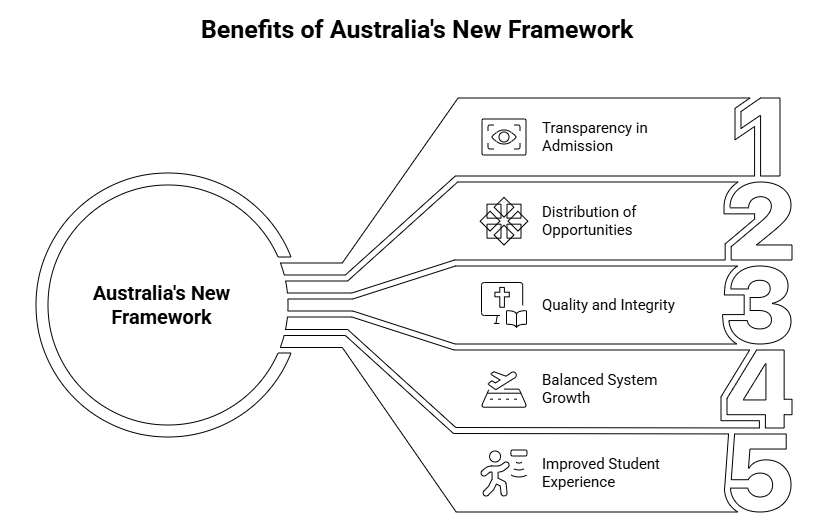Posted on November 13 2025
Breaking: Australia's NEW Visa Directive Could Cut Your Wait Time to 3 Weeks!
By , Editor
Updated November 13 2025
Highlights: Australia Unveils New Rules to Balance International Student Enrolments
- Australia has introduced Ministerial Direction 115, a new framework effective 14 November 2025, to fairly balance international student numbers across cities and regional areas.
- Institutions that stay within their 2026 planning allocations will benefit from priority visa processing, offering faster outcomes for students.
- Regional universities and smaller VET providers will gain improved access to international student allocations, supporting growth outside major cities.
- The directive ensures fair distribution of visa processing resources, preventing any provider from dominating international enrolments.
- The government will run information sessions in November and December 2025 to help institutions transition smoothly to the new system.
*Want to apply for an Australian student visa? Let Y-Axis guide you with the process.
What Ministerial Direction 115 Means for Future International Students
Australia’s new Ministerial Direction 115 aims to create a more balanced and transparent international education system. From 14 November 2025, student visa processing will be tied to how responsibly universities and colleges manage their enrolment numbers under the 2026 National Planning Level.
Institutions that stay within their allocated student limits will enjoy faster visa processing, making them more attractive choices for applicants looking for timely outcomes. This shift helps reduce pressure on major cities and ensures student opportunities are spread more evenly across the country.
Regional universities and smaller VET providers are expected to gain the most from this change. With fairer access to student allocations, these institutions can now compete more effectively with large metropolitan universities. For students, this opens doors to more study options, smoother processing times, and the added benefits that Australia already offers through regional pathways.
The directive is also designed to strengthen system integrity. It targets issues like unethical on-shore transfers and unregulated agent commissions, ensuring international students receive reliable and transparent advice throughout their journey. As part of the rollout, the government will host information sessions in November and December 2025 to help education providers prepare for the new rules.
Also, read…
Australia raises Student Visa Cap to 295,000 for 2025. Apply now!
What Indian Students Can Expect Under the New Rules
Australia’s new directive aims to make the international student system more balanced, predictable, and transparent. For Indian students, this means clearer visa timelines, fairer access to institutions across the country, and a stronger focus on student protection. The framework is designed to ensure that opportunities are not concentrated in major cities alone, while also improving the overall quality and reliability of the study experience in Australia.
Benefits for Indian Students
- Faster and more predictable visa processing when applying to institutions that stay within their approved student allocations.
- More study options in regional areas, which now receive better access to international student allocations along with benefits like extra PR points and longer post-study work rights.
- Lower living costs and strong migration pathways at regional universities and VET providers, making them attractive alternatives to big-city campuses.
- Better protection and transparency, with the government cracking down on unethical on-shore transfers and unregulated commissions to ensure students receive trustworthy advice.
- Fairer distribution of international student numbers, preventing overcrowding and ensuring a more stable and high-quality education environment across Australia.

*Want to study in Australia? Sign up with Y-Axis to connect with experienced study abroad experts.
Why Australia’s New Framework Matters for Future International Students
Australia’s updated approach to managing international student numbers isn’t just a policy change, it’s a shift towards a more stable, predictable, and student-focused education system. For future applicants, especially those from India, the new framework offers several long-term advantages.
- More transparency in the admission process: Students will know which institutions have priority processing and can make informed choices based on visa timelines and enrolment behaviour
- Better distribution of opportunities: With regional and smaller providers gaining fair access to student allocations, students have a wider range of trusted institutions to choose from.
- Higher overall quality and integrity: By discouraging practices like unethical course transfers, the directive ensures that students receive the education and support they originally signed up for.
- Balanced system growth: Ensuring that no single institution dominates international enrolments helps maintain quality across the sector and prevents overcrowding in major cities.
- Improved student experience: A more predictable system, fairer allocation of visa-processing resources, and stronger oversight provide a safer and more supportive environment for international learners.

Australia remains committed to welcoming students from around the world—but in a way that ensures the education system stays strong, fair, and sustainable for years to come. For Indian students, this means more clarity, better planning, and the confidence that your study pathway is backed by a stable national framework.
*Are you looking for step-by-step with Australia Immigration? Contact Y-Axis, the world’s No. 1 overseas immigration consultancy, for end-to-end support!
For more updates on Australia, check out Y-Axis Australia Immigration Updates!
FAQs
What is the new directive Australia has introduced to balance international student numbers?
Australia has introduced a new ministerial directive aimed at managing how international student visa applications are prioritised. Instead of placing a strict cap on student numbers, the government will now slow down visa processing for institutions that reach around 80 percent of their indicative international student intake. The goal is to distribute student numbers more evenly across regions and reduce the concentration seen in major cities. This approach encourages balanced enrolments, protects education quality and ensures that institutions do not grow too quickly in ways that strain housing or local infrastructure.
Why has Australia decided to regulate international student enrolments in 2025?
Australia has seen very high growth in international student numbers, especially in large metropolitan universities. This sudden increase has contributed to pressure on housing, infrastructure and migration systems. The government’s new directive aims to bring stability and ensure that growth remains sustainable. By managing enrolments more strategically, Australia hopes to protect its education standards, support regional institutions and maintain a balanced migration approach. The intention is not to discourage international students but to make sure the system can support them properly while meeting national goals for quality, integrity and long-term planning.
How will the new directive impact universities and private education providers?
The directive affects how quickly visa applications for each institution are processed. Once a university or private provider reaches about 80 percent of its indicative international student allocation, offshore student visa applications linked to that institution may experience slower processing. This could affect institutions heavily reliant on international enrolments, especially in major cities. Smaller and regional institutions, on the other hand, may benefit from faster processing if they still have room within their indicative numbers. The directive encourages a more even distribution of international students across the country instead of clustering in a few popular campuses.
Will the cap on international student numbers affect new student visa applications?
There is no strict numerical cap, but the prioritisation system can indirectly affect new student visa applications. If an institution reaches its allocation threshold, new offshore applications tied to that provider may take longer to process. This means prospective students might face delays, especially if they apply late or target highly crowded universities. Approval criteria remain the same, but the speed of processing changes based on how full the institution is. Students applying to regional or smaller providers may experience faster outcomes because those institutions typically have more capacity left under the new directive.
How will institutions determine their allowed intake under the new Australian student cap?
Each education provider receives an indicative allocation that outlines how many offshore international student commencements they can manage for the year. These allocations are not strict limits but guide how visa applications will be prioritised. Once an institution approaches around 80 percent of its allocation, offshore visa applications associated with it may shift to standard, slower processing. Institutions monitor their numbers through national reporting systems to understand when they are nearing the threshold. This system helps the government balance student numbers nationwide while giving universities clearer expectations about their intake capacity.
Does the directive affect students already studying in Australia?
The directive mainly targets new offshore applicants and does not affect those already studying in Australia. Current international students can continue their programs as usual, provided they meet all visa conditions. The changes do not restrict onshore applications or renewals and do not impact students transferring between courses within Australia. The focus is on managing incoming student numbers, not disrupting those who are already enrolled. This approach ensures that existing students can complete their education without facing new obstacles or changes to their current visa status.
Will the new rules impact popular courses for international students in 2025?
Popular courses—especially in large metropolitan universities—may be indirectly affected because these institutions tend to reach their allocation thresholds faster. When that happens, visa processing for new offshore students applying to those programs may slow down. This could make it harder for students to access certain courses if they apply late. On the other hand, institutions with more remaining capacity, including regional universities, may offer quicker processing and more accessible entry points. Students might consider exploring alternative locations or related programs if they want faster or smoother visa timelines.
How might this change influence visa processing and approval rates for students?
The directive does not change approval criteria but does influence processing speed. Students applying to institutions that still have space in their indicative allocation will receive faster, prioritised processing. Once an institution crosses the 80 percent mark, future offshore visa applications linked to it may experience slower timelines. Approval rates themselves remain governed by the usual visa requirements, such as financial capacity, intent, and documentation quality. Students may need to plan earlier or consider a broader range of institutions to avoid delays, especially during peak periods when popular universities fill up quickly.
Are there any exemptions or special considerations under the new student number directive?
Yes, several categories are exempt from the prioritisation thresholds. Research students, government-sponsored students, and those enrolling in certain specialised programs typically continue to receive high-priority processing regardless of institutional allocation. Onshore applicants already in Australia are also generally unaffected by the offshore prioritisation system. These exemptions ensure that Australia continues to support high-value academic pathways and honours government-to-government education commitments. Students in these categories should still follow standard visa requirements, but they are not impacted by the slower processing linked to institutional intake limits.
How will Australia ensure the new directive supports both education quality and migration goals?
Australia aims to maintain strong education standards while avoiding overcrowding in major cities. By guiding student numbers more evenly across institutions and regions, the government hopes to reduce pressure on housing, improve student experience and support sustainable migration planning. The directive encourages institutions to grow responsibly while maintaining academic quality and integrity. At the same time, regional institutions may benefit from increased interest and faster visa processing. This balanced approach helps Australia manage long-term population and workforce needs while still welcoming international students as an important part of its education and migration strategy.
Tags:
Study in Australia
Australia student visa
Australia immigration
Migrate to Australia
universities in Australia
Australia student visa processing time
Australian immigration news
Australia visas
International students in Australia
Indian students in Australia
Ministerial Direction 115
Share
Options for you by Y-Axis
Get it on your mobile
Get News alerts
Contact Y-Axis

